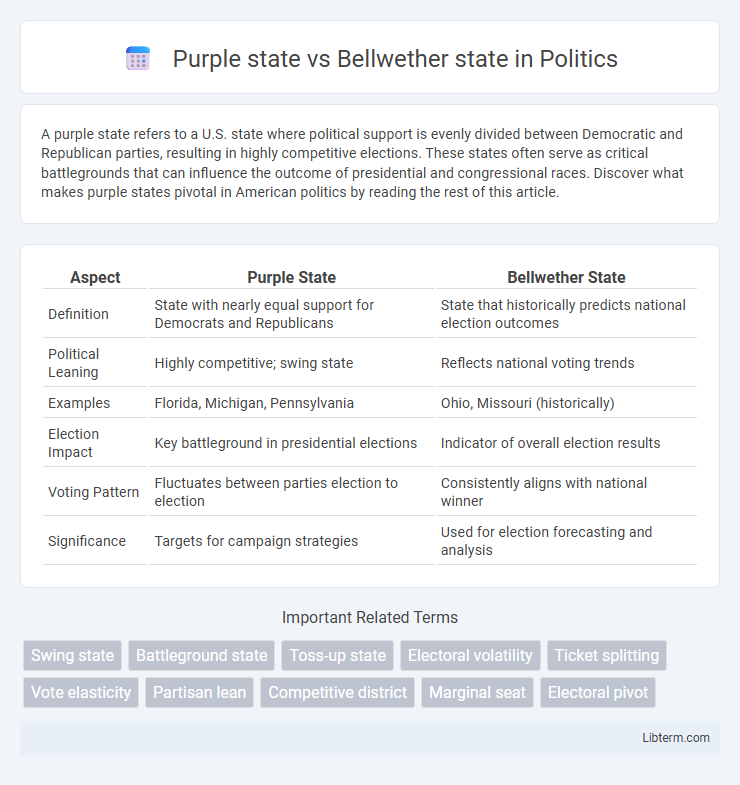A purple state refers to a U.S. state where political support is evenly divided between Democratic and Republican parties, resulting in highly competitive elections. These states often serve as critical battlegrounds that can influence the outcome of presidential and congressional races. Discover what makes purple states pivotal in American politics by reading the rest of this article.
Table of Comparison
| Aspect | Purple State | Bellwether State |
|---|---|---|
| Definition | State with nearly equal support for Democrats and Republicans | State that historically predicts national election outcomes |
| Political Leaning | Highly competitive; swing state | Reflects national voting trends |
| Examples | Florida, Michigan, Pennsylvania | Ohio, Missouri (historically) |
| Election Impact | Key battleground in presidential elections | Indicator of overall election results |
| Voting Pattern | Fluctuates between parties election to election | Consistently aligns with national winner |
| Significance | Targets for campaign strategies | Used for election forecasting and analysis |
Understanding Purple States: Definition and Significance
Purple states, also known as swing states, are U.S. states where neither the Democratic nor Republican party holds a dominant majority, making them crucial battlegrounds in presidential elections. Their voting patterns can fluctuate significantly between election cycles, reflecting a nearly even split in party support among the electorate. The importance of purple states lies in their potential to determine the overall outcome of an election, driving candidates to focus campaign resources and tailored strategies in these competitive regions.
What Is a Bellwether State? Key Characteristics
A bellwether state is a key indicator in U.S. elections that historically predicts the overall winner by closely mirroring national voting trends. These states possess a diverse demographic composition and balanced political affiliation, reflecting the broader electorate's preferences. Their electoral outcomes are highly scrutinized as they often signal the direction of the presidential race.
Historical Evolution of Purple and Bellwether States
Purple states, also known as swing states, have historically exhibited fluctuating voter preferences, shifting between Democratic and Republican parties in consecutive elections, reflecting their diverse demographic and political landscapes. Bellwether states gained prominence by consistently predicting the overall outcome of presidential elections, often aligning with the winning candidate, which made them key indicators of national political trends throughout the 20th century. Over time, demographic changes and political realignments have altered the historical consistency of bellwether states, while purple states continue to play a crucial role in determining electoral strategies due to their competitive nature.
Purple States vs Bellwether States: Core Differences
Purple states display a nearly equal split in support between major political parties during elections, making them highly competitive and unpredictable, while bellwether states historically align closely with national election outcomes, acting as indicators or predictors of the overall winner. Purple states often experience fluctuating party dominance due to demographic diversity and shifting voter preferences, whereas bellwether states maintain a consistent pattern of reflecting the national political climate. Understanding the core differences between purple and bellwether states is essential for political strategists aiming to gauge electoral trends and allocate campaign resources effectively.
Electoral Impact: Why These States Matter
Purple states wield significant electoral impact due to their fluctuating voter preferences that can swing presidential elections, making them prime targets for campaign resources. Bellwether states historically align with the winning candidate, serving as predictors of national election outcomes and influencing national party strategies. Both types of states are crucial in determining Electoral College votes, where even a small shift can alter the balance of power in tightly contested races.
Voter Demographics in Purple and Bellwether States
Purple states exhibit a diverse voter demographic with nearly equal proportions of Democratic and Republican supporters, leading to highly competitive elections. Bellwether states often have a demographic mix that closely mirrors the national electorate, making them reliable predictors of overall election outcomes. Both types of states feature shifting voter patterns influenced by factors such as age, ethnicity, and urban-rural divides, which are critical for campaign strategies and voter turnout efforts.
Case Studies: Famous Purple States in U.S. Elections
Florida and Ohio stand as prominent examples of purple states, consistently fluctuating between Democratic and Republican candidates in U.S. presidential elections, thereby reflecting the nation's electoral divisions. In the 2000 election, Florida's contested results underscored its role as a pivotal swing state, while Ohio's alignment with the winning candidate in every election since 1964 solidified its reputation as a bellwether. These states exemplify how purple states serve as crucial battlegrounds influencing electoral strategies and outcomes.
Iconic Bellwether States and Their Track Records
Iconic bellwether states like Ohio, Missouri, and Nevada have historically predicted the winner of U.S. presidential elections with remarkable accuracy, reflecting their diverse and politically balanced electorates. Ohio, known for its mix of urban and rural populations, has voted for the winning candidate in nearly every election since 1896, earning it the reputation as the quintessential bellwether state. Missouri, once considered the ultimate bellwether, matched the national outcome in all but two elections from 1904 to 2004, while Nevada's growing demographic diversity continues to make it a key indicator in recent election cycles.
Political Strategies: How Campaigns Target These States
Campaigns target purple states with tailored messaging that appeals to both moderate Democrats and Republicans, emphasizing local issues and swing voters' concerns. In bellwether states, strategies focus on demographic trends and historical voting patterns to predict and influence national election outcomes. Data-driven outreach, including microtargeting and ground game efforts, plays a crucial role in maximizing voter turnout in these pivotal regions.
Future Trends: Shifting Battlegrounds and Emerging Bellwethers
Purple states represent electoral battlegrounds with nearly equal support for major political parties, while bellwether states historically predict national election outcomes due to their consistent alignment with overall results. Future trends indicate shifting battlegrounds as demographic changes, urbanization, and political realignments transform traditional purple states, creating new contest zones. Emerging bellwether states are identified by their evolving voter profiles and reflective political behavior, making them key indicators for upcoming national election trajectories.
Purple state Infographic

 libterm.com
libterm.com